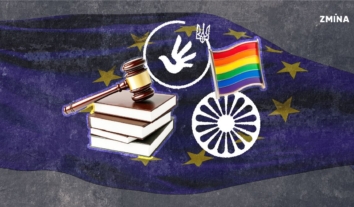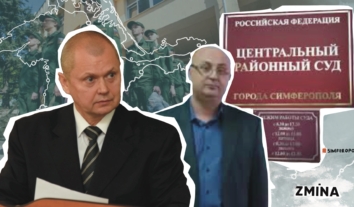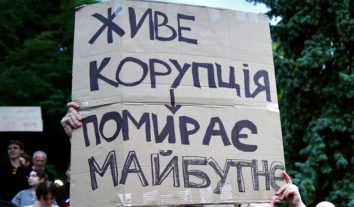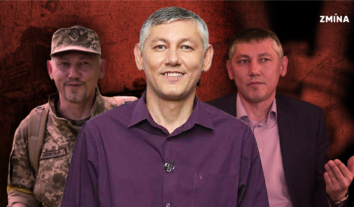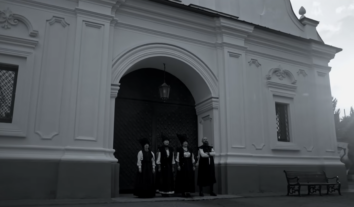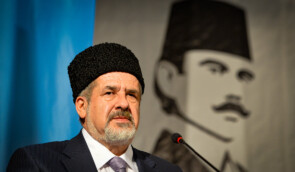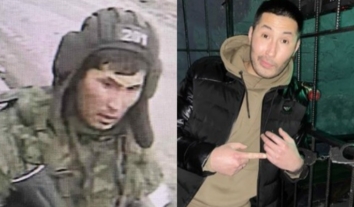Analysis of the Law on Prohibiting Communist Symbols
Volodymyr Yavorsky provides a detailed analysis of the draft Law ‘On condemning the communist and National Socialist (Nazi) totalitarian regimes and prohibiting propaganda of their symbols’ [hereafter, the Law]. He focuses on the degree to which the said bill complies with international human rights standards and practice in democratic countries.
The Law was adopted by parliament on April 9, 2015 and has been passed to the President for his signature. It had been tabled on April 6, and was adopted according to accelerated procedure, with no possibility of making amendments to the bill.
Content
The Law
1) Bans propaganda of communist and / or National-Socialist (Nazi) totalitarian regimes;
2) Bans the symbols of communist and / or National-Socialist (Nazi) totalitarian regimes according to the list provided, including:
– any images of state flags, crests, and other symbols of the USSR, Ukrainian SSR, other members of the Union or autonomous Soviet republics within the USSR, or so-called ‘people’s democracies’;
– anthems of the USSR, Ukrainian SSR, other members of the Union or autonomous Soviet republics within the USSR, or fragments of them;
– flags, symbols, images or other representing a hammer and sickle together; a hammer, sickle and 5-pointed star; a plough; hammer and 5-pointed star;
– symbols of the communist party or its elements and others.
3) Bans the creation and orders the forced termination of any legal entity propagating communist and / or National-Socialist (Nazi) totalitarian regimes, or uses their symbols.
By propaganda of communist and / or National-Socialist (Nazi) totalitarian regimes, the Law specifies 3 separate actions:
1) Public denial, including via the media, of the criminal nature of the communist totalitarian regime of 1917-1991 in Ukraine; the National-Socialist (Nazi) totalitarian regime;
2) Circulation of information aimed at justification of the criminal nature of the communist, National-Socialist (Nazi) totalitarian regimes, the activities of the Soviet Security Services; the establishment of Soviet power on the territory of Ukraine or in individual administrative-territorial units; the fight against participants in the struggle for Ukraine’s independence in the XX century;
3) Preparation and / or circulation, as well as the public use of products which contain the symbols of the communist, National-Socialist (Nazi) totalitarian regimes.
The Law bans the preparation, circulation, and the public use of symbols of the communist totalitarian regime, including souvenirs, symbols of the National-Socialist (Nazi) totalitarian regime, public performance of the anthems of the USSR, Ukrainian SSR, other members of the Union or autonomous Soviet republics within the USSR, or fragments of them.
This ban does not apply to use of symbols:
1) in museums;
2) in theme-based exhibits;
3) in academic, educational manuals, textbooks and other material of an educational and academic nature (on condition that this does not lead to denial of the criminal nature of the communist totalitarian regime of 1917-1991 in Ukraine; the National-Socialist (Nazi) totalitarian regime) in the course of academic research and the circulation of its results in manners not prohibited by Ukrainian legislation;
4) on gravestones; monuments and memorial plaques in graveyards (cemeteries);
5) during the teaching or reconstruction (including historical) of historical events, as well as on the collecting of such symbols.
The Law also establishes criminal liability for the preparation, circulation, as well as the public use of symbols of the communist totalitarian regime, National-Socialist (Nazi) totalitarian regimes, including souvenirs, symbols of the National-Socialist (Nazi) totalitarian regime, public performance of the anthems of the USSR, Ukrainian SSR, other members of the Union or autonomous Soviet republics within the USSR, or fragments of them, aside from the above-listed five exceptions. Such activities are punishable by restriction of liberty for up to five years or deprivation of liberty for the same period, with or without confiscation of property. If these actions are committed by a representative of the authorities, or repeated, or committed by an organized group, or with the use of the media, they are punishable by deprivation of liberty for a period from 5 to 10 years with or without confiscation of property.
This Law also prohibits the broadcasting by TV or radio broadcasters of audio-visual material which:
1) contain a denial of the criminal nature of the communist totalitarian regime of 1917-1991 in Ukraine; the National-Socialist (Nazi) totalitarian regime;
2) which creates a positive image of people who held leading positions in the communist party, starting from the posts of secretary of a district committee and higher, the higher bodies of power and government of the USSR, Ukrainian SSR, other Soviet republics (except for cases linked with the development of Ukrainian science and culture); employees of the Soviet bodies of State Security.
3) justifies the activities of the Soviet security services;
4) justifies the establishment of Soviet rule on the territory of Ukraine or in specific administrative-territorial units;
5) justifies the fight against participants in the struggle for Ukraine’s independence in the XX century.
The Law also restricts electoral rights, for example, the right to stand for election as a deputy or for the post of President if the person is put forward by a party which propagates the above-mentioned regimes or their symbols. It is in effect banned to use communist or Nazi symbols in the electoral process.
The Law separately stipulates the procedure for the changing of geographical names, as well as the dismantling of monuments which propagate the above-mentioned regimes or their symbols.
Experience of other countries
Some countries (for example, the Czech Republic; Hungary; Lithuania; Moldova and Poland) have in the past adopted legislation banning communist symbols and the propagating of communism.
Czechoslovakia
In 1991 a new offence linked with propaganda of movements aimed at crushing rights and freedoms or inciting ethnic or racial enmity was added to the criminal code. Nazi and communist regimes were cited as examples. Later the Constitutional Court recognized these provisions to be constitutional, however stated that communism and Nazi ideology were not clearly defined concepts. In addition, certain actions, should they be carried out, were covered among the elements of other crimes. In the light of this judgement, mention of Nazism and communism were later removed from the description of the new offence.
Hungary
In 2000 criminal liability was imposed for circulating or publicly using or displaying a swastika, SS symbols (the Siegrune); the hammer and sickle; red star or any symbols using them. A fine was imposed for these actions.
The use of these symbols for educational, academic, artistic purposes or to provide information about history was not an offence, nor the use of countries’ current symbols.
In 2000 Hungary’s Constitutional Court found no infringement of the Constitution in these provisions.
In 2008, in the case of Vajnai v. Hungary, the European Court of Human Rights found the imposition of a fine on a demonstrator for wearing a red star to be a breach of the right to freedom of expression.
In 2011, in the case of Fratanoló v. Hungary, ECHR issued an analogous judgement.
On Feb 19, 2011, the Constitutional Court found the ban to be unconstitutional.
Lithuania
Since June 2010 there has been a ban and criminal liability for denial of the crimes of the communist and Nazi regimes.
Since June 2008 there has been an administrative penalty (fine) for the circulation and display of communist and Nazi symbols. There are only two cases known where this has been applied, with both under court consideration for several years.
Poland
In 1997 criminal liability was introduced for propaganda of totalitarian ideology, including Nazi and communist, as well as the preparation, sale, purchase or use of products linked with it, including communist and Nazi symbols. There was no punishment if the actions were committed for academic, educational, artistic or collecting purposes.
On July 19, 2011 Poland’s Constitutional Court found these provisions to be unconstitutional due to their violation of freedom of expression.
Moldova
In 2012 a ban was introduced on the use of communist symbols, including in the names of legal entities (political parties, etc.). However the Constitutional Court, citing among others the Joint Amicus Curiae Brief for the Constitutional Court of Moldova from the Council of Europe’s Venice Commission, found these norms of legislation to be unconstitutional.
A number of other countries (for example, Albania, the Czech Republic; Germany; Italy and Slovakia) have adopted legislation imposing a general ban on totalitarian ideology and its symbols. Communist ideology or symbols are not specifically mentioned.
In Germany there is liability for the use of symbols of prohibited parties. In 1956 the Constitutional Court of the Federal Republic of Germany banned the German Communist Party and accordingly its symbols. However in 1969 another German Communist Party was created which has existed to the present day and uses communist symbols, including the hammer and sickle joined with a 5-point red star.
In Germany criminal liability is not imposed if the prohibited symbols are used for research, study or education, as well as for artistic purposes or in order to present information about historical events, or for any other similar purpose.
There is a third group of countries where there is only criminal liability for the use of Nazi symbols and of exclusively Nazi propaganda. This group includes Austria; Belarus; Brazil; France; the Russian Federation and some others.
Compliance with international human rights standards
Prohibition of the use of communist symbols is an undoubted intrusion into freedom of expression; freedom of association (through restrictions on the creation of political parties, civic associations, etc.); freedom of peaceful assembly (through the ban on their use at gatherings); and of electoral rights (through the restriction on parties and their candidates taking part in elections).
Such interference may be deemed admissible in accordance with the Constitution and international law if it is carried out in accordance with the law ; pursues a legitimate goal and is necessary in a democratic country.
In accordance with the law means that the law must be suitably clear and foreseeable, while it must also be comply with international human rights standards.
Restrictions on human rights may only be made in order to protect the rights and freedoms of others; to protect public order, territorial integrity or state sovereignty. It is clear that the law is aimed primarily at protecting these values.
The law must be necessary in a democratic society, that is, any restrictions on rights must be dictated by social necessity with the government unable to achieve this aim via any other means. Necessity in a democratic society demands proportional restrictions by the state to achieve legitimate ends.
Freedom of expression
The banning of the broadcasting, preparation, and use of communist and Nazi symbols is an undoubted intrusion into freedom of expression. One therefore needs to determine whether such intrusion by the state is legitimate.
The restriction is envisaged by a law, but this law contains significant failings. It is clear from the above-mentioned Venice Commission opinion on a similar law in Moldova, as well as European Court of Human Rights case law, that the list of banned symbols must be exhaustive.
The draft Law does not provide an exhaustive list of symbols, and some provisions of the list clearly require additional clarification. For example, the limits on the use of the 5-pointed red star seem rather contradictory. It is not clear whether it falls under the total ban as a symbol of the communist party, or only in combination with other communist symbols.
The Polish, Czech and Moldovan Constitutional Courts have pointed in their judgements to the lack of clarity of the concepts ‘totalitarian regimes’; ‘communist regimes’ and ‘communist symbol’. Is any communist or Nazi ideology banned, or only individual elements of such ideology? Such excessively broad bans were deemed by these courts to violate the principle of legal clarity.
You can also not call the provisions banning audio-visual works on radio or television clear. Such terms as “creates a positive image”; “justifies”; “denial of the criminal nature” apply solely to value judgements. In many works it would be difficult to determine whether they create a positive image or justify something.
The criterion for defining something as propaganda is “denial of the criminal nature” of the regime, though here again the concept is not very clear what exactly you can’t deny. With respect to Nazi crimes, it is clear since these were clearly defined by the Nuremberg Tribunal. Unfortunately there was no such tribunal with respect to the crimes of the communist period. It is therefore unclear what specific facts may not be denied.
The fact that the criteria for the ban are based primarily on value judgements is a serious practical problem. Broadcasters may not realize that they are breaking the law due to such unclear wording. If an expert assessment is needed to decide whether they are in breach, who is to carry it out, and who decides that it’s needed? The Law provides no guidance whatsoever, meaning that such bans will not be applied, or will be applied selectively, at the regulator’s discretion.
A fundamental principle of freedom of speech is that liability cannot be imposed for value judgements, nor can these be banned. Liability is possible only for incorrect facts or in rare cases offence. There can thus be liability for denial of the Holocaust, Holodomor or facts of political repression in Soviet times, etc. “Justification”, on the other hand, or “denial of the criminal nature” are solely in the realm of value judgements, and their prohibition is therefore an infringement of freedom of speech.
Furthermore, these judgements are banned even for academic purposes – something not seen in any European country – since the only exceptions are academic publications which “do not deny the criminal nature of communism”. This effectively terminates discussion on historical facts or research.
The most difficult issue is whether the interference is necessary in a democratic society. There needs to be a direct threat to territorial integrity; state sovereignty; public order or to the rights of others, and the threat cannot be removed by other means. Proving such a need in each specific case could be difficult since the Law does not link the use of symbols with specific prohibited aims, but prohibits the very fact of their use. In such circumstances it will be impossible to prove the need to apply punishment for the use of symbols if the person did not have any overt criminal aims. In practice, any conviction will be solely over the use of symbols with the aim not being taken into account at all.
Need in a democratic society also requires proportionate restrictions by the state to achieve legitimate goals. Restriction of liberty for 5 years as the most lenient punishment for the use of communist symbols is clearly disproportionate and a violation of human rights. Such harsh punishment cannot be found in any European country and it could clearly cause numerous cases of political persecution for expressing views. Fines are not even envisaged as punishment, and restriction or deprivation of liberty is manifestly disproportionate to the threat from such expression of views. Furthermore the sanctions are solely for expression of views, and not for actions themselves, directly aimed at overturning state sovereignty, infringements of territorial integrity, etc.
In the case of Vaijnaj v. Hungary, the European Court of Human Rights stipulated that propaganda of communist totalitarian ideology, albeit very bad, could not be the sole grounds for banning the use of symbols and applying criminal punishment.
In assessing a similar law in Moldova, the Venice Commission found such a ban “unacceptably broad”. Instead of prosecuting those who used the symbols to incite hatred or violence, the law envisaged the prohibition of certain symbols for any purpose, including those carrying no risk to the public.
The Law envisages criminal prosecution for the use of communist symbols in the media. International law is scrupulous in its approach to possible conviction and sentencing to terms of imprisonment for publications in the press. There are European Court of Human Rights judgements where this has been found acceptable, but most often a fine is involved, not imprisonment. In the case of imprisonment for just quoting the leaders of the Communist Party of the Soviet Union, this will definitely be deemed disproportionate punishment.
In view of this, the Law sets the ground for serious restrictions of freedom of expression which will be in breach of Ukraine’s Constitution and the European Convention on Human Rights.
Freedom of Association and Peaceful Assembly
The Law bans the creation or activities of any legal entities which:
1) use communist or Nazi symbols in their names;
2) have propaganda of communist and / or National-Socialist (Nazi) totalitarian regimes and their symbols in their founding documents.
In accordance with the clear and unequivocal practice of the European Court of Human Rights, the dissolution of a political party is possible only because of the party’s activities, and not its name, symbols or even the continue of its charter. Only specific actions aimed at restrictions of human rights; violation of territorial integrity or sovereignty can be grounds for a political party’s dissolution. As well as the Communist Party of Ukraine itself, there are numerous other parties which use “communist symbols”. They have used them up till now completely legally and not caused any significant harm. Therefore the existence of any such organization, including the Communist Party of Ukraine must be viewed in the context of their activities.
The European Court of Human Rights has also indicated in numerous cases that such a serious measure as the dissolution of a party or ban on its creation should be applied in extreme cases. Each time the scale of the threat posed by their existence must be assessed with view to the proportionality of the measure. Furthermore, only the activities of the party, not anything in its charter alone, can justify forced dissolution.
As mentioned, the concept of propaganda is not clearly defined rendering it open to different interpretation. If some degree of clarity in determining the use of symbols in the name is possible, there are considerable difficulties over founding documents since these by their nature define only the aims of the organization and are not aimed at “justifying” the regime or denying any particular historical facts. It is unclear from the law whether any communist party that has aims compatible with democratic aims, should change its name, or only where the party stipulates its support for the ‘dictatorship of the proletariat’.
The Law overall makes it irrelevant what activities a legal entity engages in. The very fact of its use of communist or Nazi symbols is sufficient for its dissolution. This despite the fact that use of communist symbols does not per se indicate support for totalitarian regimes.
In view of this, the ban on a legal entity by the court over the use of symbols is, in our opinion, a breach of the Constitution and European Convention on Human Rights.
This Law will result in a number of organizations being banned due to the formal feature of having communist symbols. However in the near future, as was the case at the beginning of the 1990s, after a Constitutional Court judgement on the Communist Party of Ukraine or a judgement from the European Court of Human Rights. Furthermore these formal grounds for banning the communist party will in fact make it possible for the latter to escape liability and more well-founded grounds for its dissolution over its activities in 2014.
The Law with respect to restrictions on the name of legal entities clearly fails to comply with the European Convention on Human Rights since it undoubtedly violates freedom of association. Such bans cannot be absolute bans that do not depend on the context and assessment of the real actions of the legal entity. Each specific ban should be based on the aims which the activities of the specific organization pursue. Any automatic bans in such cases are a clear breach of human rights. Unfortunately the Law has removed any possibility for the court to take an individual approach to the dissolution of this or that organization since the court will consider only the formal use of prohibited symbols.
Electoral rights
The same considerations for determining the grounds for restriction of electoral rights apply as those considered above for other restrictions of rights.
The Law prohibits any political party to put forward candidates for deputy at any level or for President if they carry out propaganda of communist and/or National-Socialist (Nazi) totalitarian regimes , their symbols or where a decision has been taken according to the procedure passed by the Cabinet of Ministers regarding incompatibility of the party’s activities, name and / or symbols to the Law “On condemnation of communist and/or National-Socialist (Nazi) totalitarian regimes and ban of propaganda of their symbols.
The main problem is that this party is not considered dissolve until its registration has been terminated by the Justice Ministry on the basis of a court ruling which came into force after appeal. However the law bans parties which remain legal and not dissolved from taking part in the elections. This is a manifest breach of the Constitution and European human rights standards.
General assessment and proposals regarding necessary amendments.
Decommunization is a necessary element of Ukraine’s desovietization. In view of this, we welcome condemnation of the communist regime for the mass violations of human rights that took place during the Soviet period.
However condemnation via an act of parliament is not sufficient. The criminal nature of the regime should be determined by confirmed crimes, and not political acts. For this court, and not parliamentary procedure is clearly needed. Specific crimes of the communist regime confirmed and established by a court should become the basis for formal acts banning denial of these crimes. We previously noted that denial of Nazi crimes is a more valid offence since the crimes of Nazism have been clearly set out through judicial procedure. In view of this, it is possible to recognize as legitimate punishment for denial of the Holocaust. It is much more complicated with the crimes of communism since they have not been established through judicial procedure. For this reason, the concept of establishing bans on the basis of “denial of the criminal nature” of the communist regime moves us into the realm of value judgements, and not facts. This is a major difference in the basis for treatment of Nazi crimes and crimes of the communist regime of the USSR. There were previously attempts to define some crimes of Soviet times, however they were to a large extent unsuccessful. There needs to be clearly clearer definition and qualification of the crimes of the communist regime to establish the relevant prohibitions on their denial.
One can as a whole welcome steps towards opening the State archives which provide still more information about the crimes committed in Soviet times, and also makes it possible to reveal the truth about those who were unjustly convicted or repressed in Soviet times. However we would note that amendments to laws with regard to the archives requires separate study since they also contain a number of contradictory provisions, for example with respect to protect of the right to privacy and practical issues in exercising the relevant legal norms.
One positive step is the change and removal of Soviet geographical names. Another important step is establishing order to the police on various monuments, for example, the creation of a register of monuments protected by the state and also the dismantling of monuments to the USSR or people responsible for policies against people during Soviet times.
However the Law passed has a number of failings which overall will cause more harm in the future, than benefit to the public. It unwarrantedly sets the ground for social conflict which could be avoided without endangering the overall purpose of decommunization.
Three main problematical areas in the Law can be identified.
1) Propaganda undoubtedly uses certain symbols which convey the essence of the ideology to a person in brief form. Yet certain symbols to not indicate the automatic propaganda of a certain ideology. Many symbols that are used have a less established and fairly broad application, especially when you move beyond the framework of how they are perceived at a purely national level. In view of this, the use of certain symbols could be banned when linked with the aim of such actions, but not autonomously or independently.
This is the logic by which the legislation of western countries has developed after a general ban on use of symbols was found to be unconstitutional in a number of countries. In the majority of countries there is a ban on propaganda of Nazism, and in some communism as well, as an ideology dangerous for democracy. In some there is a ban on any totalitarian ideology. Such propaganda can be carried out via certain symbols, however this can only be one of the elements of the offence. In view of this, a ban on the isolated use of certain symbols is possible solely in connection with the propaganda of ban ideologies which are against human rights and democracy.
2) Virtually in all the limited number of countries which adopted bans on the use of symbols or ideology, such a ban does not apply to art or academic research. The draft law passed by Ukraine’s parliament, unfortunately, only restricts application of the law in the case of exhibitions and museums which are a small part of art. The law also contains restrictions for academic research since they must “not deny the criminal nature of the communist totalitarian regime of 1917-1991.” We said above that this issue is not clearly defined. One can deny certain facts, however it is not clear how to define the denial of “the criminal nature” which concerns solely value judgements. Clearly such wording can potentially restrict academic research since any research about the Soviet period could fall under such restriction. Such a ban on the use of symbols in art and science does not comply either with European standards, or with the practice of European countries that have taken similar steps on decommunization. There are no restrictions in European countries on the use of symbols for academic or artistic purposes. In effect, artists, art specialists or academics could be faced with criminal prosecution, rather than politicians who actually threaten the state or society. This law effectively bans literature, visual arts or other means of art work from the Soviet period which is a manifest violation of human rights.
3) A third important issue with the law passed is the clearly disproportionately severe punishment for preparation or use of symbols. Imprisonment up to 5 years for any display of Nazi or communist symbols is manifestly and undeniably in breach of international human rights standards. It also in no way complies with the practice of other countries where for such actions only an administrative fine is envisaged. The proposed system of punishments needs urgent review, and criminal liability in this sphere needs to be rejected.
The State has the right to ban certain symbols and propaganda of certain ideology. However such a ban must meet certain requirements in order to comply with European human rights standards.
1) The law must be clear and foreseeable, the list of symbols and elements of ideology should be clearly formulated (preferably with pictures of such symbols), the provisions of the legislation should be maximally clear and unequivocal;
2) Such a ban should serve only the purposes defined for restriction of human rights, and there can therefore be no liability for simply using symbols where this is not linked with the threat of propaganda of prohibited ideology.
3) Such a ban should be necessary in a democratic society with this meaning that such a need must be proven in each case of punishment, and the punishment must be proportionate to the threat to the interests protected by the State.
In view of the above, we suggest that the President returns the bill to parliament for refinement and for the above-mentioned three problematical areas of the bill to be removed. In order to observe human rights, the following amendments are required:
1) Narrow the list of communist symbols and make an exhaustive list, preferably adding the images in colour;
2) Allow the use of prohibited symbols in art, science and for other “non-political” purposes;
3) Ban the use of communist and Nazi symbols for the purpose of propaganda of communism and Nazism;
4) Ban full use of communist and Nazi symbols by the authorities or for commercial purposes;
5) Exclude the restrictions on names for legal entities, as well as with respect to bans on communist symbols;
6) Exclude restrictions of electoral rights, including the possibility of registered parties and other associations putting forward candidates for deputy;
7) Exclude imprisonment as punishment, replacing this with less severe sanctions, and best, impose administrative liability for the relevant offences. At the same time, as mentioned above, the elements making up this offence need to be narrowed.


